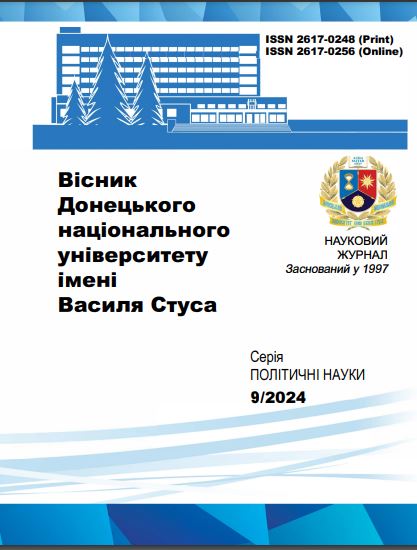Dynamics of asymmetry in relations between China and Australia
DOI:
https://doi.org/10.31558/2617-0248.2024.9.18Keywords:
asymmetry, China, Australia, asymmetric relations, Sino-Australian relationsAbstract
The article examines the asymmetric relationship between Australia and China, explores their interdependence, the origins of tensions and the prospects for their cooperation. It is noted that asymmetry, being a regulator of international relations and the key to understanding their complex nature, is important for the analysis of relations not only between neighboring states, but also between influential global and regional power centers. Sino-Australian relations are a complete reflection of asymmetry, as it permeates almost all spheres of their interaction. These relations are unstable because China, aware of its dominance in the sphere of economy and security, sharply reacts to actions of Canberra that are threatening from Beijing's point of view. China, based on self-confidence as a global economic power, the military hegemon of the region, turns the asymmetry of relations between countries into a specific political problem. It has been found that China uses its military-political, economic power and security primacy as a lever to influence Australia, thereby limiting its economic interests. While Australia has been vulnerable in its asymmetric relationship with China (especially in the economic sphere), it has demonstrated that it is not a helpless and passive actor when faced with Beijing's coercive economic restrictions. Despite Canberra's deepening diplomatic confrontation with Beijing, a significant rift between the states is unlikely. In addition, China also needs a reliable exporter of high-quality raw materials and food products. So it is likely that Australia's political future will be closely tied to China and the US. Against the backdrop of asymmetric relations, mutually compatible preferences, interests, and attention to power asymmetry can neutralize misperceptions and confrontations between actors and promote peaceful coexistence between them.
References
Australia, New Zealand, and China: a Bumpy Ride Towards a Dialogue. Martens Сentr. 29 June 2021. Access mode: https://www.martenscentre.eu/blog/australia-new-zealand-and-china-a-bumpy-ride-towards-a-dialogue/ (accessed 15.05.2024)
Ayson R. Choosing ahead of time? Australia, New Zealand and the US-China contest in Asia. Contemporary Southeast Asia. 2012. 34(3). Р. 338–364. doi:10.1355/cs34-3b
Blaxland J. Strategic Balancing Act: Australia’s Approach to Managing China, the USA and Regional Security Priorities. Security Challenges, Vol. 13, No. 1, Getting the Balance Right (2017), pp. 19-40.
Harman R. Hello China. How America is withdrawing from Asia. Politik. 2019e, July 18. Access mode: http://politik.co.nz/en/content/foreignaffairs/1607/ (accessed 15.05.2024)
Kizeková, A. (2021). Taking stock of Australia’s asymmetrical relations with China: interdependence, tensions, and new dimensions. Journal of Contemporary Eastern Asia, 20(2), 197–209. Access mode: https://doi.org/10.17477/jcea.2021.20.2.197 (accessed 15.05.2024)
Köllner P. Australia and New Zealand recalibrate their China policies: convergence and divergence. The Pacific Review. 2021. Volume 34, Issue 3. P. 405–436. Access mode: https://doi.org/10.1080/09512748.2019.1683598 (accessed 15.05.2024)
Laurenceson J., Zhou M., Pantle T. Interrogating Chinese economic coercion the Australian experience since 2017. Security Challenges, Vol. 16, No. 4, Geo-Economics in the Indo-Pacific (2020), pp. 3-23
Pan G. Ineffective Communication: Why and How Australia and China Talk Past Each Other. Australian Institute of International Affairs. 15 MAR 2024. Access mode: https://www.internationalaffairs.org.au/australianoutlook/ineffective-communication-why-and-how-australia-and-china-talk-past-each-other/ (accessed 16.05.2024)
Tow S. R. Diplomacy in an asymmetric alliance International Relations of the Asia-Pacific. Oxford University Press. Vol. 12, No. 1 (2012), pp. 71-100. Access mode: https://www.jstor.org/stable/26155942
(accessed 15.05.2024)
Uren D. Australia’s Asymmetrical Trade with China Offers Little Room to Move. | Australian Strategic Policy Institute. 11/10/2020
Vijaya, P. (2021) Australia’s role in the quad and its crumbling ties with China. Journal of Indo-Pacific Affairs, 4 (9). pp. 136-144. Access mode: https://pure.jgu.edu.in/id/eprint/1725/ (accessed 16.05.2024)
Waltz K. The Emerging Structure of International Politics. International Security. 1993. Vol. 18, No. 2. P. 44–79.
Ward A. and Mcleary P. Biden announces joint deal with U.K. and Australia to counter China. Politiko. 09/15/2021
Womack, B., 2004. Asymmetry Theory and China’s Concept of Multipolarity. Journal of Contemporary China, 13 (39), рр.351-366. Access mode: <https://pdfs.semanticscholar.org/ed61/fecb11d32e3eda43377b76c31d4799483056.pdf> (accessed 17.05.2024)
Womack, B., 2006. China and Vietnam: The Politics of Asymmetry. New York: Cambridge University Press.
Womack B. China as a normative foreign policy actor. CEPS Centre for European Policy Studies, 2008. рр.265-299.
Womack, B., 2010. China Among Unequals: Asymmetric Foreign Relationships in Asia. Singapore: World Scientific.
Womack B. Asymmetry and China’s Tributary System. Oxford, Journals Social Sciences Chinese Journal of International Politics. 2012. Vol. 5, Issue 1, March. Access mode: https://academic.oup.com/cjip/article/5/1/ 37/343602 (accessed 17.05.2024)
Womack, B., 2016. Asymmetry and International Relationships. New York: Cambridge University Press.
Zhou Fangyin. China-Australia Relations and China’s Policy Choices toward Australia. China Review. Vol. 23, No. 1, 2023, pp. 213-242.The Chinese University of Hong Kong Press

